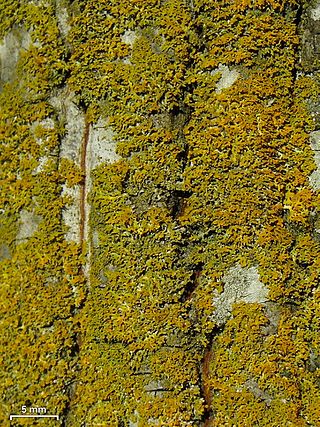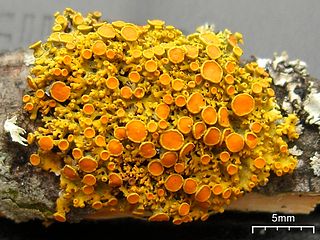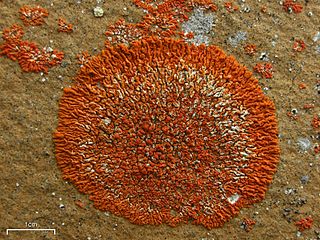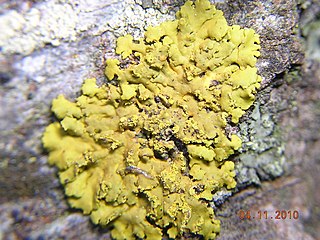Related Research Articles

The Teloschistaceae are a large family of mostly lichen-forming fungi belonging to the class Lecanoromycetes in the division Ascomycota. Many members of the Teloschistaceae are readily identifiable by their vibrant orange to yellow hue, a result of its frequent anthraquinone content. The presence of these anthraquinone pigments, which confer protection from ultraviolet light, enabled this group to expand from shaded forest habitats to harsher environmental conditions of sunny and arid ecosystems during the Late Cretaceous. Collectively, the family has a cosmopolitan distribution, although members occur predominantly in subtropical and temperate regions. Although most members either live on rock or on bark, about 40 species are lichenicolous–meaning they live on other lichens.

Rusavskia elegans, commonly known as the elegant sunburst lichen, is a lichenized species of fungus in the genus Rusavskia, family Teloschistaceae. Recognized by its bright orange or red pigmentation, this species grows on rocks, often near bird or rodent perches. It has a circumpolar and alpine distribution. It was one of the first lichens to be used for the rock-face dating method known as lichenometry.

Enterographa is a genus of lichens in the family Roccellaceae.
André Aptroot is a Dutch mycologist and lichenologist.
Josef Hafellner is an Austrian mycologist and lichenologist. He was awarded the Acharius Medal in 2016 for his lifetime contributions to lichenology. Before his retirement, he was a professor at the Karl-Franzens-Universität in Graz. Hafellner started developing an interest in lichens while he was a student at this institution, studying under Josef Poelt. He earned a master's degree in 1975 and a PhD in 1978, defending a doctoral thesis about the genus Karschia. In 2003, Hafellner received his habilitation. By this time, he had studied with French lichenologist André Bellemère (1927–2014) at Saint-Cloud, where he learned techniques of transmission electron microscopy and how their application in studying asci could be used in lichen systematics. His 1984 work Studien in Richtung einer natürlicheren Gliederung der Sammelfamilien Lecanoraceae und Lecideaceae has been described as "probably the single most influential publication in lichen systematics in the latter half of the 20th century".
Thomas Hawkes Nash III is an American lichenologist. His research is about the biology and ecology of lichens, and the effects of air pollution on plants and lichens. He is known as an authority on the family Parmeliaceae. During his long career at the Arizona State University, he helped develop the lichen herbarium into a world-class collection with over 100,000 specimens representing more than 5000 species. In 2010, the year of his retirement, he was awarded the Acharius Medal for lifetime achievements in lichenology, and the following year had a Festschrift published in his honor.

Gallowayella is a genus of lichen-forming fungi in the family Teloschistaceae. It has 15 species. The genus was circumscribed in 2012 by Sergey Kondratyuk, Natalya Fedorenko, Soili Stenroos, Ingvar Kärnefelt, Jack Elix, and Arne Thell, with Gallowayella coppinsii assigned as the type species. The generic name honours New Zealand lichenologist David John Galloway (1942–2014).
Klaus Kalb is a German lichenologist and an authority on tropical lichens.
Filsoniana is a genus of squamulose lichens in the family Teloschistaceae. It has six species. It was circumscribed in 2013 by Ingvar Kärnefelt, Arne Thell, Jae-Seoun Hur, Sergey Kondratyuk, and John Elix following a molecular phylogenetic analysis of the Teloschistaceae. The generic name honours Australian lichenologist Rex Filson, "in recognition of his contribution to lichenology, in particular to the lichen flora of Australia".
Henricus (Harrie) Johannes Maria Sipman is a Dutch lichenologist. He specialises in tropical and subtropical lichens, and has authored or co-authored more than 250 scientific publications. He was the curator of the lichen herbarium at the Berlin Botanical Garden and Botanical Museum from 1983 until his retirement in 2010.

Siegfried Huneck was a German chemist and lichenologist. Much of his scientific career was hampered by the political situation in the former German Democratic Republic. He rejected pursuing a career in academia, and instead ended up working at the Leibniz Institute of Plant Biochemistry, a public research institute, from 1969 until his retirement in 1993. Despite his relative isolation and restricted freedoms in East Germany, Huneck had numerous professional contacts both in Germany and abroad, and was a highly published scholar. Many of his more than 400 scientific publications dealt with the chemistry of lichen products. He was awarded the Acharius Medal for lifetime achievements in lichenology in 1996.

Robert Lücking is a German lichenologist. He earned his master's and PhD from the University of Ulm, focusing on the taxonomy, ecology, and biodiversity of foliicolous lichens. He has received numerous awards for his work, including the Mason E. Hale award for his doctoral thesis, the Augustin Pyramus de Candolle prize for his monograph, and the Tuckerman Award twice for his publications in The Bryologist. Since 2015, he has been serving as the curator of lichens, fungi, and bryophytes at the Berlin Botanical Garden and Botanical Museum, and several lichen species and a genus have been named in his honour.

Gallowayella hasseana, the poplar sunburst lichen, is a species of corticolous (bark-dwelling), crustose lichen in the family Teloschistaceae. It occurs in North America.
Jackelixia whinrayi is a lichen in the family Teloschistaceae. It was first described in 2007 by Sergey Kondratyuk and Ingvar Kärnefelt as Xanthoria whinrayi, but was transferred to the genus Jackelixia in 2009 by Kondratyuk, Natalya M. Fedorenko, Soili Kristina Stenroos, Kärnefelt, and Arne Thell.

Rusavskia is a genus of lichen-forming fungi in the family Teloschistaceae. It has 12 species. It is a member of the subfamily Xanthorioideae. The thallus of Rusavskia is characterized by its foliose (leaf-like) structure with distinct and typically narrow lobes that curve outwards.

Martinjahnsia is a single-species fungal genus in the family Teloschistaceae. It contains the sole species Martinjahnsia resendei, a saxicolous (rock-dwelling) crustose lichen.

Gallowayella fulva is a species of foliose lichen in the family Teloschistaceae. It was first scientifically described in 1796 by German lichenologist Georg Franz Hoffmann, who classified it as a member of genus Lobaria. It has also been classified in the genera Oxneria, Xanthomendoza and Xanthoria in its taxonomic history. Sergey Kondratyuk and colleagues transferred the taxon to the genus Gallowayella in 2012, based on a molecular phylogenetics-based restructuring of some genera in the subfamily Xanthorioideae of family Teloschistaceae. In North America, one vernacular name for the species is the bare-bottomed sunburst lichen.
Xanthoria yorkensis is a species of corticolous (bark-dwelling), crustose lichen in the family Teloschistaceae. Found in South Australia, it was formally described as a new species in 2009 by lichenologists Sergey Kondratyuk and Ingvar Kärnefelt. The type specimen, collected along the Maitland road in Yorke Peninsula, was found growing on Melaleuca trees in mallee scrub. The species epithet refers to its type locality, the only place the lichen is known to occur. Kondratyuk and colleagues proposed to transfer the taxon to the newly circumscribed Jackelixia in 2009, but this genus has not been widely accepted by other authorities.
Xanthoria kangarooensis is a species of corticolous (bark-dwelling), crustose lichen in the family Teloschistaceae. Found in Australia, it was formally described as a new species in 2009 by lichenologists Sergey Kondratyuk and Ingvar Kärnefelt. The type specimen was collected from East Kangaroo Island, where it was found growing on dead Lycium ferocissimum shrubs. Other associated lichens include species of Pyxine, Ramalina, and Rinodina. The species epithet kangarooensis refers to its type locality, the only place the lichen is known to occur. Kondratyuk and colleagues proposed to transfer the taxon to the newly circumscribed Jackelixia in 2009, but this genus has not been widely accepted by other authorities.
Cerothallia yarraensis is a species of corticolous (bark-dwelling), crustose lichen in the family Teloschistaceae. Found in Australia, it was formally described as a new species in 2009 by lichenologists Sergey Kondratyuk and Ingvar Kärnefelt, as Caloplaca yarraensis. Kondratyuk and colleagues transferred it to the genus Cerothallia in 2014.
References
- ↑ "Seaward, Mark R.D. (fl. 2004)". International Plant Names Index . Retrieved 28 August 2022.
- 1 2 Hawksworth, David L.; Coppins, Brian J. (2018). "A tribute to Mark Seaward, environmental lichenologist and recorder par excellence, at eighty". The Lichenologist. 50 (6): 599–602. doi:10.1017/s0024282918000488.
- ↑ Kondratyuk, S.Y.; Kärnefelt, I.; Lőkös, L.; Hur, J.S.; Thell, A. (2018). "Coppinsiella and Seawardiella – two new genera of the Xanthorioideae (Teloschistaceae, Lichen-Forming Ascomycota)". Acta Botanica Hungarica. 60 (3–4): 369–386.
- ↑ Aptroot, A.; Sipman, H.J.M. (2001). "New Hong Kong lichens, ascomycetes and lichenicolous fungi". Journal of the Hattori Botanical Laboratory. 91: 317–343.
- ↑ Sparrius, L.B. (2004). "A monograph of Enterographa and Sclerophyton". Bibliotheca Lichenologica. 89: 56.
- ↑ Aptroot, A. (2008). "Lichens of St Helena and Ascension Island". Botanical Journal of the Linnean Society. 158: 147–171 [160].
- ↑ Kondratyuk, S.Y.; Kärnefelt, I.; Elix, J.A.; Thell, A. (2009). "Contributions to the Teloschistaceae, with particular reference to the Southern Hemisphere". Bibliotheca Lichenologica. 100 (389): 207–282 [266].
- ↑ Kukwa, M.; Schiefelbein, U.; Flakus, A. (2013). "A contribution to the lichen family Graphidaceae (Ostropales, Ascomycota) of Bolivia". Herzogia. 26 (2): 231–252 [242].